
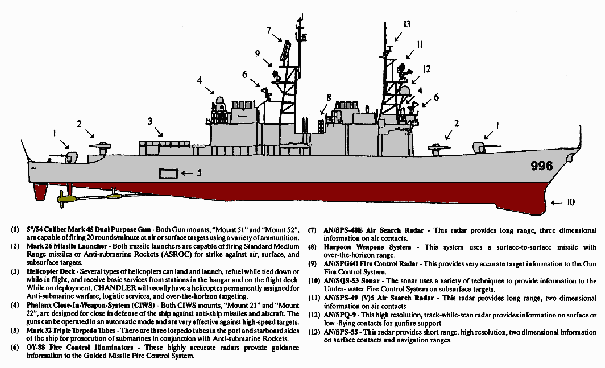
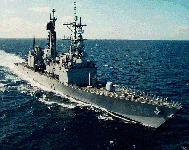
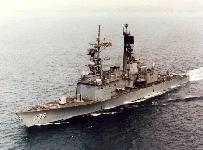

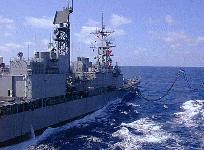
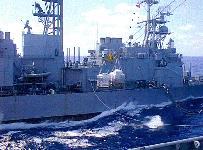
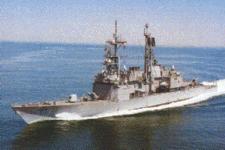
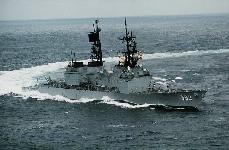
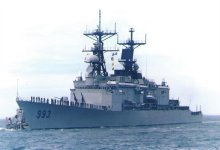




On 01 December 1998 the Department of Defense announced that the Government of Greece had requested a possible combined lease/sale arrangement of four KIDD Class Guided Missile Destroyers and related munition items and services relating to "hot ship" turnover of one KIDD Class destroyer, "cold ship" transfer reactivations for three KIDD Class destroyers from the US Navy.
Built for action in the Persian Gulf, these ships are oriented for general purpose operations rather than specialized anti-submarine war.These ships feature advanced air-intake and filtration systems in order to handle dust and sand prevailing in Persian Gulf operating area as well as greater air-conditioning capacity. With the ability to fire surface-to-air missiles in support of Aegis cruisers, which, if necessary, can assume control of the destroyer's missiles. The guided-missile destroyers are outfitted with air-defense radar that allows them to command a wide ocean area. They can also support amphibious landing forces.
KIDD-class armaments include the New Threat Upgrade (NTU) anti-air warfare (AAW) system to improve their anti-air warfare performance against the technologically advanced threat expected into the 21st century, as well as two Mk 26 launchers for Standard surface-to-air missiles, and SQS-58 hull mounted active sonar, ASROC, eight Harpoon surface-to-surface missiles, two five-inch guns and hangar facilities for one Lamps Mk 1 helicopter. The most formidable warship of her size ever to patrol the world's oceans, blending the best features of the SPRUANCE Class destroyers with the combat system of the VIRGINIA Class nuclear cruisers to produce a ship with unique characteristics:The most sophisticated medium-range AAW systems in the Fleet, quick-reacting and highly accurate, with the capability for today's air defense environment and the growth potential for tomorrow's.
An exceptionally reliable and responsive engineering plant.
A deadly surface-to-surface weapons capability.
KIDD's combat system is her complement of weapons and electronics subsystems and equipment, which collectively enables her to carry out combat missions.
AAW: Anti-Air Warfare
ELW: Electronic Warfare
The ship's Electronic Warfare Sensor is designated as an anti-ship missile defense sensor. It provides rapid and automatic detection, processing, and analysis of enemy electronic emissions. It is used with four deck-mounted Super Rapid-Blooming Off-board Chaff (SRBOC) mortar-type launchers, which provide defense against homing missiles by creating deceptive chaff targets.
Communication
KIDD has a modern, automated communications system. For Fleet Broadcast Traffic, the Naval Modular Automated Communication System (NAVMACS) A-Plus uses a computer for automated message processing. NAVMACS is joined with a satellite communications transceiver and a satellite receiver to provide high-speed, low- interference information transfer via satellite links. For two-way tactical communications, KIDD carries a full range of modern UHF, VHF, and HF
radio equipment.
Only one ship of this class remains active U.S. Navy service. The remaining three ships of this class, the USS Kidd (DDG-993), USS Callaghan (DDG-994), and USS Scott (DDG-995) are scheduled for transfer to a foreign navy under the Security Assistance Program (SAP).
Specifications | |
| Power plant | 4 - LM 2500 General Electric gas turbines, 80,000 shaft horsepower two shafts, |
| Length | 563 feet (171.6 meters) |
| Beam | 55 feet (16.8 meters) |
| Displacement | Light Displacement: 7289 tons Full Displacement: 9783 tons Dead Weight: 2494 tons |
| Speed | 33 knots (38 mph, 60.8 kph) |
| Aircraft | 1 - SH-3 helicopter or 2 - SH-2 Seasprite LAMPS helicopter |
| Armament |
2 - Mk26 launchers for Standard Missile 2 - MK 141 quad launchers w/ 8 Harpoon missiles 2 - MK 15 20mm Phalanx CIWS Close-In Weapons Systems 2 - 5-Inch 54 Cal. MK 45 Guns (lightweight gun) 2 - MK 32 triple tube mounts w/ six Mk-46 torpedoes) MK 112 Launcher for ASROC |
| Combat Systems |
SPS-48E Air Search Radar SPG-60 Gun Fire Control Radar SPS-55 Surface Search Radar SPQ-9A Gun Fire Control Radar SQS-53 Sonar SLQ-32 (V)3 OUTBOARD II |
| Unit Operating Cost Annual Average | ~$25,000,000 [source: [FY1996 VAMOSC] |
Ships | ||||||
| Name | Number | Builder | Homeport | Ordered | Commissioned | Decommissioned |
| Kidd | DDG 993 | Ingalls | 23 Mar 1978 | 27 Mar 1981 | 12 Mar 1998 | |
| Callaghan | DDG 994 | Ingalls | Everett | 23 Mar 1978 | 29 Aug 1981 | 31 Mar 1998 |
| Scott | DDG 995 | Ingalls | Mayport | 23 Mar 1978 | 24 Oct 1981 | 11 Dec 1998 |
| Chandler | DDG 996 | Ingalls | Everett | 23 Mar 1978 | 13 Mar 1982 | 1999 |









